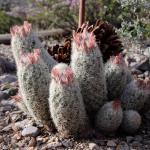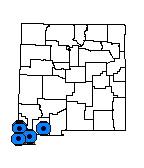Description
Escobaria orcuttii is distinguished by the relatively even and short length of the central spines, which seem to grade into the radial spines of similar length. This gives the plants something of a "groomed" appearance.
Stems solitary, few in a clump, or commonly branched to form small dense clusters, the individual stems up to 6 cm thick and 15 cm tall; tubercles on mature stems with upper surface bearing a groove; spines whitish, usually with purplish or brownish tips, often brittle and breaking readily at the touch, about 45-60 per areole, spreading, about 70 percent slender and about 8 mm long, the remainder thicker and 9-11 mm long; flowers not opening widely, to 2 cm wide (usually smaller); tepals pale yellowish to pinkish or nearly white, usually with midribs darker, stigmas white to pink; fruits elongate, 1.5-2 cm long, green to somewhat reddish; seeds about 1 mm long, kidney-shaped, pitted, brown, with hilum lateral. Flowers April and May.
Similar Species
Escobaria tuberculosa usually has more richly colored flowers that open widely, fruits that ripen bright red, and seeds that are smaller and rounder. Escobaria orcuttii is larger and less densely clustering than E. sneedii var. sneedii or E. sneedii var. leei. The allopatric E. albicolumnaria, E. organensis, E. sandbergii, and E. villardii are very similar, but have longer central spines.
Distribution
New Mexico, Hidalgo and Luna counties; Mexico, southward to central Chihuahua.
Escobaria orcuttii occurs strictly on limestone west of the Rio Grande from the Santa Eulalia Mountains, Chihuahua to the vicinities of Samalayuca and Juarez, Chihuahua and into southwestern New Mexico. In New Mexico, populations occur in the Peloncillo Mountains (Higalgo County, also Cochise County, Arizona), Florida Mountains (Luna County), Big Hatchet Mountains (Hidalgo County), and possibly in the Little Hatchet Mountains (Grant and Hidalgo counties) and Animas Mountains (Hidalgo County). The range is not well documented in Mexico, but the taxon likely occurs on many limestone outcrops near the west edge of the Chihuahuan Desert in northern Chihuahua. This distribution seems quite large, but the plant is restricted to limestone outcrops, and at any given location has only been found in small areas with relatively few individuals.
Habitat
In cracks in limestone or in rocky soils of broken mountainous terrain in Chihuahuan desert scrub, desert grassland, and oak woodland; 1,600-1,800 m (5,200-6,000 ft).
Conservation Considerations
Of limited distribution, but sometimes locally abundant. Introduced grazing animals threaten to extirpate populations in the Florida Mountains. A few portions of populations in Chihuahua are impacted by mining activity. Overall, most populations seem in good condition.
Important Literature
*New Mexico Native Plants Protection Advisory Committee. 1984. A handbook of rare and endemic plants of New Mexico. University of New Mexico Press, Albuquerque.
*Castetter, E.F., P. Pierce and K.H. Schwerin. 1975. Reassessment of the genus Escobaria. Cactus and Succulent Journal (U.S.) 47(2):60-70.
*Zimmerman, D.A. 1972. Comments on certain southwestern coryphanthas of the subgenus Escobaria. Cactus and Succulent Journal (U.S.) 44(3):155-158.
Flora of North America Editorial Committee. 2003. Flora of North America, volume 4. Oxford University Press, New York.









